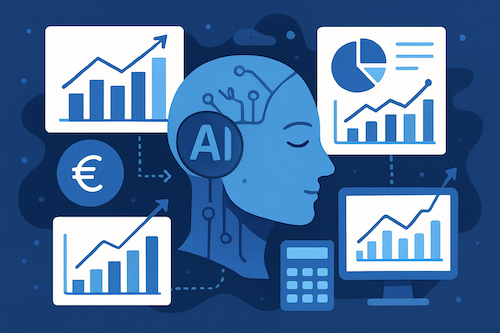
Table of Contents
Financial Planning & Analysis (FP&A) sits at a critical juncture within modern enterprises. It’s the function tasked with navigating financial futures, steering strategy through budgets, forecasts, and insightful analysis. For years, automation has chipped away at the repetitive tasks, freeing up analysts from the drudgery of data consolidation. But are we fully leveraging the technological potential? My research indicates that Artificial Intelligence (AI) offers capabilities far beyond just doing the old tasks faster.
Moving Past Basic Automation
We’ve seen basic automation, often through Robotic Process Automation (RPA) or sophisticated scripting, handle predictable, rules-based activities quite well. Think data aggregation from various sources or generating standard monthly reports. These are valuable efficiency gains, no doubt. Yet, true AI, particularly machine learning (ML), moves into the realm of cognitive augmentation, tackling tasks that previously demanded significant human judgment and analytical horsepower.
Enhanced Forecasting Capabilities
Consider forecasting. Traditional methods often rely on historical trends and relatively simple driver-based models. AI introduces a step-change. Machine learning algorithms can analyze vast datasets, incorporating not just internal financials but also external factors – macroeconomic indicators, industry trends, even competitor activities – to generate forecasts with potentially greater accuracy and nuance. These models can identify complex, non-linear relationships that might elude conventional approaches, offering a more dynamic view of potential futures. Isn’t that a more powerful starting point for strategic discussion?
Sophisticated Scenario Planning
Scenario planning also gets a significant upgrade. Instead of analysts manually adjusting a few key variables, AI can run thousands, even millions, of simulations rapidly. It can explore the potential impact of interacting variables in ways that are simply impractical manually. This allows for a more robust understanding of risk and opportunity under a much wider range of conditions. What hidden sensitivities might your current model be missing? AI helps uncover them.
Intelligent Anomaly Detection
Anomaly detection represents another potent application. AI algorithms excel at identifying patterns that deviate from the norm within large datasets. Applied to budgets, forecasts, or actual results, this capability can flag potential errors, unexpected operational issues, or even fraudulent activity far faster than manual reviews. It acts as an early warning system, drawing analyst attention to areas needing investigation. (Think of it as a tireless digital assistant constantly scanning for outliers).
Incorporating Qualitative Insights
Furthermore, Natural Language Processing (NLP), a subset of AI, is starting to make inroads. Imagine systems that can analyze commentary within financial reports, parse earnings call transcripts, or even scan relevant news feeds to extract qualitative insights that enrich quantitative models. This bridges the gap between the numbers and the narrative, providing a more holistic analytical picture.
Considerations for Implementation
Of course, embracing these advanced capabilities isn’t without its analytical considerations. The quality and structure of underlying data remain paramount – AI models are only as good as the data they’re trained on. Integrating these tools effectively often requires connecting them with existing BI platforms (like Power BI or Tableau, which remain vital for visualization and user interaction) and demands professionals skilled in both finance and data science concepts. It’s less about replacing analysts and more about equipping them with fundamentally more powerful tools.
The Evolving Role of FP&A
The trajectory seems clear. AI is poised to elevate FP&A from a historically backward-looking reporting function to a genuinely forward-looking strategic partner. By moving beyond basic automation to leverage predictive forecasting, intelligent scenario analysis, and anomaly detection, organizations can unlock deeper financial insights and navigate uncertainty with greater confidence.
What are your thoughts on AI’s role in FP&A? Let’s connect and discuss on LinkedIn.